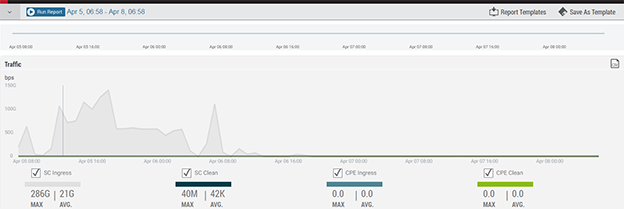Background:
Starting on April 1st, one of the most popular gaming operators from a large Asia-Pacific (APAC) country has suffered DDoS attacks, rendering the application unreachable and many gamers frustrated. It was a massive spoofed-IPs attack against the user authentication ports. After several attempts to mitigate the attack, the customer turned to a local cloud provider – who is a Radware partner - for help. As one the largest providers in APAC they took a stab at fighting the attack off, and called Radware to the battlefield.

This was sophisticated combat, as it turned out. The customer has experienced multi-vector attacks in varying rates and random bursts of hundreds of Gbps each peak. The vector blend was changing and it was clear that the attackers are not only determined to knock the service offline, but keep it down as well.

Figure 1 – Traffic rates throughout the attack campaign

Figure 2 – Traffic rates throughout the attack campaign
We gathered our Emergency Response Team (ERT) DDoS mitigation experts for a round-the-clock fight. This type of attack highlights the need to have experts on call in the moment of truth. The experience of a senior engineer pays off.
Attack Characteristics – Why Spoofed IPs?
The attackers launched a sustained series of precise and high volume floods comprised of the following characteristics:
- Professional – neither a novice hacker nor a plug-n-play DDoS-as-a-Service program carried out this attack campaign. The determination and methodic development of the campaign proved it to be a job done by networking experts.
- Multiple, constantly changing vectors - including SYN floods, ACK floods, UDP floods, TCP reset attacks and fragmented UDP floods on multiple ports simultaneously, in different blend compositions.
- Geographic distribution – to bypass any geo-location based protection
- Bursts - A sustained high volume attack combined with high volume peaks every 5 to 15 minutes.
- Spoofed IPs – Most DDoS protection solutions use IP blacklisting mechanisms and cannot withstand a dynamic spoofed IPs attack. Not only these are limited by the capacity to store lists of IP addresses, in the case of constantly changing spoofed IPs, blacklisting – and ACL updates – are meaningless.
They probably expected the provider to drop the upstream router link at a certain high volume. But that didn’t happen. Using a dedicated signature, we could block the malicious traffic regardless of its IP address.

Figure 3 & 4 – Attack bursts of random durations every few minutes

“Most DDoS Protection solutions use IP blacklisting mechanisms and cannot withhold a dynamic spoofed IPs attack. This is another indication that this campaign was launched by professionals who knew exactly how to breach through a typical cloud provider DDoS protection”
[You might also like: Ask Yourself: Do I Need an Emergency Response Plan? WHY?]

Figure 5 & 6 – sustained attacks’ duration varied from minutes to hours to days

Attack mitigation:
Radware’s ERT team used several techniques in their battle against the attackers, in order to avoid even a minor impact on the users. They made multiple network optimization actions and security tunings in order to control and manage the attack traffic, including network optimization actions to adjust to the attack volume and vectors. While the initial burst caused an interruption, it allowed us to refine the tunings further, resulting in an ultimate consistency of mitigation of nearly a 100% of the attack duration.
Following the engagement of Radware’s ERT, the burst attacks have become much more complex, frequent and of longer duration, presumably due to their recognized lack of success.
At the end of the day, there are three key elements in successful mitigation, where one cannot go without the other:
- The technology – a behavioral analysis engine that detects anomalies in real time and protects legitimate users while blocking the attack traffic
- The scrubbing capacity – a broad network of high capacity scrubbing centers in various locations. Yet. even an endless capacity cannot fully protect customer SLA without the ability to distinguish between attack traffic and legitimate requests
- The human factor – against a team of sophisticated, determined professionals, you need a team of more sophisticated, devoted experts to win the cyber-battle
These subsequent bursts too, have been fully mitigated with no apparent or reported impact on game functionality – the SLA was protected!
Radware’s ERT remains on alert, believing the attackers will return with more sophisticated, aggressive tactics.

Read the 2016–2017 Global Application & Network Security Report by Radware’s Emergency Response Team.
Download Now